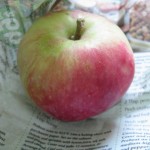 I came upstairs from a round of apple-wrapping to find some questions on apple preserving from Ruth, who is the lucky recipient of a quantity of hangingoverthefence apples.
I came upstairs from a round of apple-wrapping to find some questions on apple preserving from Ruth, who is the lucky recipient of a quantity of hangingoverthefence apples.
Like me, she had heard that wrapping apples individually in newspaper is the way to go. She’d read that coloured inks are toxic so to avoid those, but I’ve been told that Canadian newspapers use soy-based colour inks so they are ok (but glossy inserts are not). (I don’t know if this is really the case or not, so if in doubt, avoid them.) I’d heard it from the Compost Education Centre which suggests that you can add newspaper to your compost (for a “brown” layer), which means the apple wrapping can do double duty if you end up with some spoilage later in the season: you can just chuck the whole thing into the pile. The point of wrapping is to keep the apples from spoiling one another if they’re bruised or damaged. Lacking a root cellar, I am fortunate to have a little bar fridge that I use just for apples and it works reasonably well.
My first year of bounty, Adrienne gave me a wonderfully liberating tip: you can pee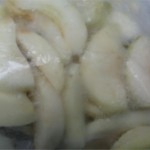 l, core and slice apples and put them in ziplocks in the freezer – works brilliantly for cooking apples. Don’t worry if they brown a little en route to the freezer as they go brown when you cook them anyway. But I suppose if you can’t bear the thought of any brown, you can always dip them in syrup while you work, as the PickYourOwn folks recommend. But I don’t find they brown too badly if you work quickly on fresh and fully ripe apples. The ones in the picture were frozen a year ago with no syrup or preservative: I’d still use them in baking.
l, core and slice apples and put them in ziplocks in the freezer – works brilliantly for cooking apples. Don’t worry if they brown a little en route to the freezer as they go brown when you cook them anyway. But I suppose if you can’t bear the thought of any brown, you can always dip them in syrup while you work, as the PickYourOwn folks recommend. But I don’t find they brown too badly if you work quickly on fresh and fully ripe apples. The ones in the picture were frozen a year ago with no syrup or preservative: I’d still use them in baking.
If the apples are of a fairly firm texture you can slice and dehydrate them (my tree is a yellow transparent, which produces very soft apples great for applesauce but impossible for drying). Here are some instructions on drying apples in a dehydrator, an oven or a hot car!
I have an apple peeling machine which makes a lot of the labour-intensive aspects slightly less so. As long as you’re dealing with firm, regularly-shaped and very fresh apples. It doesn’t work well on my transparents which tend to be soft and misshapen. It’s also less frugal than I when it comes to peeling and coring: such is the trade-off with labour saving devices of all kinds.
Or you can make applesauce and can that – it’s a high acid food so you don’t need a pressure canner, just a pot large enough to cover the jars with water and process (boil) for 20-25 minutes depending on the jar size and altitude (again from the PickYourOwn website, good instructions on applesauce, with photos) I’ve made it with plums or quince and those are nice combinations; perhaps saskatoon-applesauce or raspberry-applesauce would be good if you have an alternative source of berries.
I own a centrifugal juicing machine so that’s what I use. Because my apples are very tart I always add carrots for sweetener (sugar as a last resort); or blend them with sweeter varieties or other fruit. This year I decided to use up some surplus jam from my larder, so I 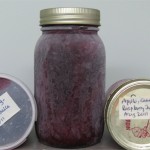 heated that and added it to blackberries I’d picked, and strained the juice and used that for sweetener. I also used raspberries and carrots. I don’t have a recipe, just go by taste. I put the juice into jars or plastic tubs, cover them and freeze them. Because the liquid expands while freezing, if you’re using screw-top jars, be sure to leave the lids loose until the liquid freezes, to avoid any messy explosions.
heated that and added it to blackberries I’d picked, and strained the juice and used that for sweetener. I also used raspberries and carrots. I don’t have a recipe, just go by taste. I put the juice into jars or plastic tubs, cover them and freeze them. Because the liquid expands while freezing, if you’re using screw-top jars, be sure to leave the lids loose until the liquid freezes, to avoid any messy explosions.
I have made apple butter in years past, but find I don’t use it.


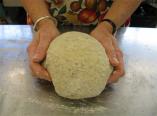
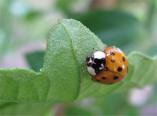



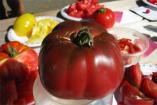


2 Responses to Preserving the harvest: apples